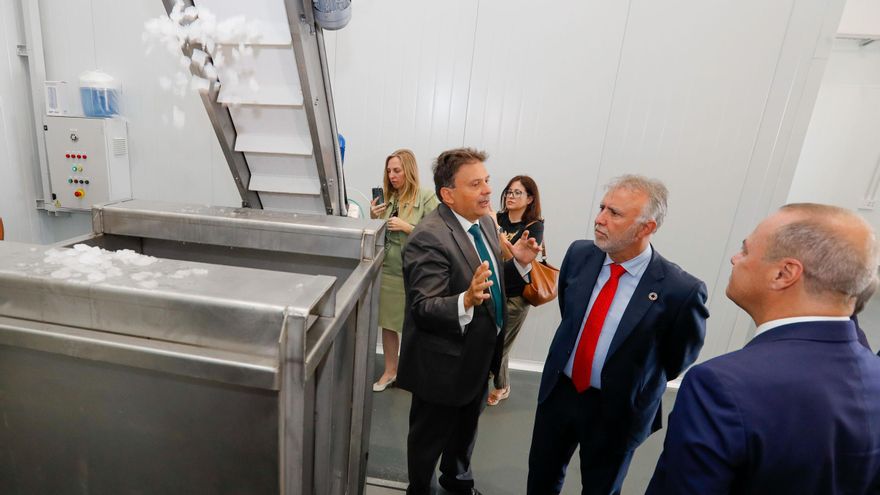
Only the fresh fish was missing. A broad political representation headed by the President of the Government of the Canary Islands, Angel Victor Torresthe mayor of the city, Augusto Hidalgo, and the president of the Port of Las Palmas, Luis Ibarrahave presented to society the ice machine that Fishermen’s Association of San Cristóbal (Pescatobal) premieres at the facilities of Hispano Suizos SA Refrigerators (Frisu).
The company has ceded a part of its warehouse in the fishing pier to make the return of fresh catch to the Port of La Luz and Las Palmas a reality, an area that ran out of this attraction in 2011, when the Ojeda factory closed and artisanal fishing boats began to go to Tenerife to stock up on ice, a essential element to keep the catches in good condition and to be able to fish in the island fishing grounds.
“We are going to unload 200 tons of fish a year and move our boats here,” says the president of the San Cristóbal Fishermen’s Association, Jose Manuel Saavedra Robainathe only one that is still active in Las Palmas de Gran Canaria.
Saavedra explains that the pier ofhe fishing district of San Cristóbal it barely allows them to fish because the large sandbanks prevent the entry and exit of boats during empty tide. Hence the joy of the sector for the agreement reached with the Las Palmas Port Authority (APLP), whose president, Luis Ibarra, expects La Luz to move between five and six tons of fresh fish a year thanks to the new infrastructure.
The ingenuity has the capacity to manufacture 20 tons of ice daily. Hence, the machine not only covers the needs of the San Cristóbal Fishermen’s Association, but also of any ship that needs the service and opts for the Fishing Dock to market its merchandise.
The next step will be to open a point of first sale, actions with which the Port of Las Palmas he wants to reach those five or six tons of fresh fish per year. This is a very small amount compared to the movements of frozen fishing, but with a high symbolic value due to the recovery of the fishing image and the “historical” flavor of this trade, adds Ibarra.
The investment made amounts to around 300,000 euros, destined in large part to the restructuring of the Fransar jettyi so that small fishing boats can dock. At present there are five or six established permanently, but the Brotherhood of San Cristóbal hopes that they will move 20 shipspractically the entirety of its fleet.
For the moment, more points need to be placed on the pontoon to increase its capacity and moor the boats more safely, vertically, because horizontally, which is how the moorings were planned, two nacelles have suffered damage to their sides due to the resonance of the water generated by large ships when they enter and leave the Port.
Another action that fishermen demand is to have a free space on the dock to be able to work with the nets and the rest of the fishing gear. The satisfaction of the sector, in any case, is immense. “This is an advance of hell the candle,” he confesses sebastian mirandapattern of Daddy Chanoa cute eight-meter-long red boat specialized in the art of potting, trammel netting and tuna angling, among other fish.
Miranda’s boat is one of those that cannot enter or leave San Cristóbal at low tide because it runs aground on the sandbanks of the pier. Hence the advantages of transferring to the Port of Las Palmas, where, without additional costs, fishermen have a berth and an ice machine for their catches, saving travel to the Santa Cruz de Tenerife fishing dock.
The sailors, faced with operational problems in San Cristóbal, had been using the sports pieran enclosure that is not planned for this activity, which generated discussions with the Civil Guard about the traceability of the fish caught, among other issues.
Juan Simon Morera Batista, another fisherman, has a boat with more capacity than his fellow fisherman Miranda. He usually unloads about 10 tons of fresh fish every 15 days, so he often has to go to Tenerife, Morocco or Arguineguín to cover his ice needs. “Going to Tenerife means 50 more miles of fuel and one less day of rest for the crew,” says Morera, who celebrates the commitment of the Port of Las Palmas to recover this traditional activity. His boat is one of the few that continue to fish on the Saharan bank.
The president of the San Cristóbal cooperative appreciates the initiative, which he also describes as “advance”, because “we were unloading at the Sports Dock without the necessary conditions”, clarifies José Manuel Saavedra. Not only the twenty ships of the brotherhood will benefit from the new facilities, but all those of Gran Canaria and those who come from abroad.
The mayor of Las Palmas de Gran Canaria, Augusto Hidalgo, went further and highlighted the added value that the reactivation of the Fishing Dock represents for the city, because that area at the entrance to the Port is called to be completely transformed in the next five years, with the reform of the shopping center, the workshop for large yachts and the future projected urban park.
The President of the Government of the Canary Islands, Ángel Víctor Torres, praised Ibarra’s efforts to solve the problem of the brotherhood and recover the fishing tradition of the Port of Las Palmas, because “We have to defend and have the best possible primary sector”underlines the president.
















